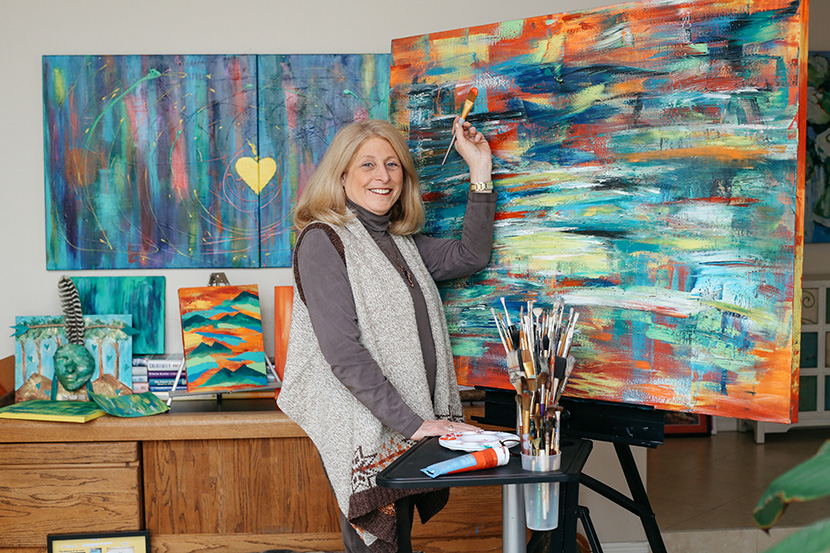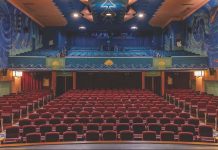
By Ashley Ryan
Coloring books are no longer only for kids as more and more adults are discovering that the pastime goes beyond just filling blank pages with shades of color. Therapy centered on art and creativity has been steadily gaining interest across the nation as a way to destress and find inner peace. In Newport Beach, Dr. Jane Goldberg, founder of the Expressive Arts Training Institute, teaches workshops like Colors of Creativity, Sand-Tray and Story Telling, and Music, Rhythm & Song in an effort to elevate her patients’ spirits and open their hearts. Here, Goldberg shares a glimpse into this new trend and its many benefits.
Newport Beach Magazine: How do you distinguish expressive arts therapy from other forms?
Jane Goldberg: All therapy is about learning to love yourself and others and expressing that love authentically out in the world. It doesn’t matter if you sing it, paint it, dance it, write it or speak it out loud. Expressive arts therapy is an amazing opportunity to express creatively all that you are and, by doing so, to appreciate and acknowledge the many dimensions of your being—your heart, mind, body and spirit.
NBM: What exactly does this type of therapy entail?
JG: To bring our best selves forward—to bypass fears, anxieties, worries, addictions, anger, unhealthy relationships—it is necessary to release the energy held inside the body by first accessing the imagery or story that arises from our creative unconscious mind and then to bring it forth. When we can look at it, we can learn from it. For example, when you are feeling lost or confused, creating a collage with pictures and words from a magazine will illuminate your situation and give you wisdom about it. Just [by] looking at it, you might feel proud of yourself and love it, thereby raising your self-esteem and returning to a state of joy and freedom.
NBM: How does the process work?
JG: The multidimensional approach of the arts expands and deepens the change process. People tend to be some combination of visual, auditory or kinesthetic. When we invite people to use all three representational systems, they get the information on more levels of their consciousness. The arts access the right brain connections to images, expression, emotions, music, spontaneity, mystery, intuition, nonlinear thinking and dreams. It is believed that healing occurs in these realms and is brought back into the left brain where they find their logic, language and order. Utilizing both sides of the brain in this manner awakens the connections, crossing synapses in the brain that keep our minds young and alive.
NBM: Can you talk about some of the benefits of art therapy?
JG: Art and music affect every cell in the body to create a healing physiology that changes the immune system and allows blood flow to the organs. Dabbling in the arts changes a person’s attitude, emotional state, pain perception and perspective of the world. The art modalities create hope and positivity and open us to faith and forgiveness, gratitude and grace. In fact, it is now known by neurophysiologists that art … and healing are all associated with similar brain wave patterns and they are all deeply connected in feeling and meaning.
NBM: Art therapy has been around for a long time, but why do you think it has been gaining popularity in recent years?
JG: This year, there has been an explosion of adult coloring books everywhere. This phenomenon reflects our society’s desire to find peace and calm, quiet playtime, release, beauty and vibrancy in our everyday lives—and rightly so. We require this state of relaxation and flow for balance and well-being. It is essential that we find a way to include this extroverted meditative time. It takes us to an inner stillness through movement repetition; it slows us down and fulfills our need for color, design and form.
NBM: How has it evolved since it was first introduced?
JG: In the early 1970s, The National Expressive Therapy Association was birthed and it attracted those who were both called to the vocation of therapist and to being an artist. The president, Steve Ross, imagined a field of artist-therapists, who were able to use creative artistic rituals and ceremony alongside deep caring to heal and strengthen those who were experiencing loss, struggle and pain. Since that time it has grown internationally—there are expressive arts therapists in [many] countries. It has also begun to expand in the last 10 years with new research about neuroplasticity and the recognition that we can grow new cells.




